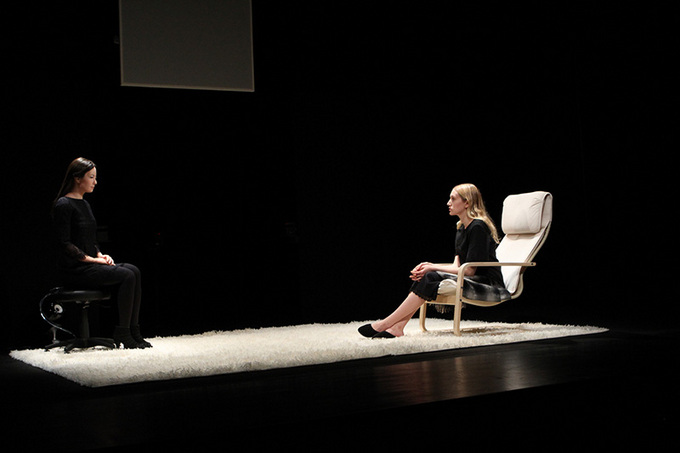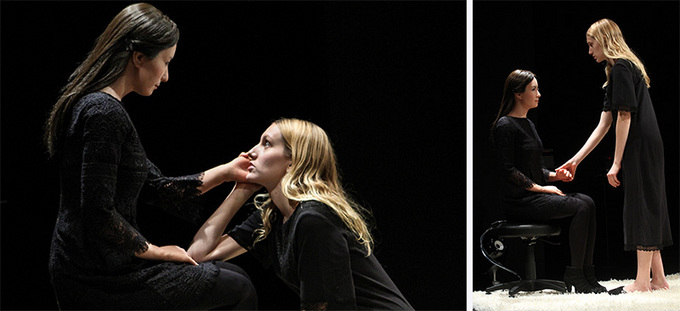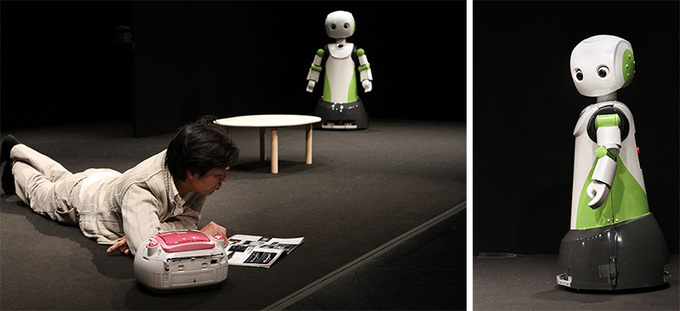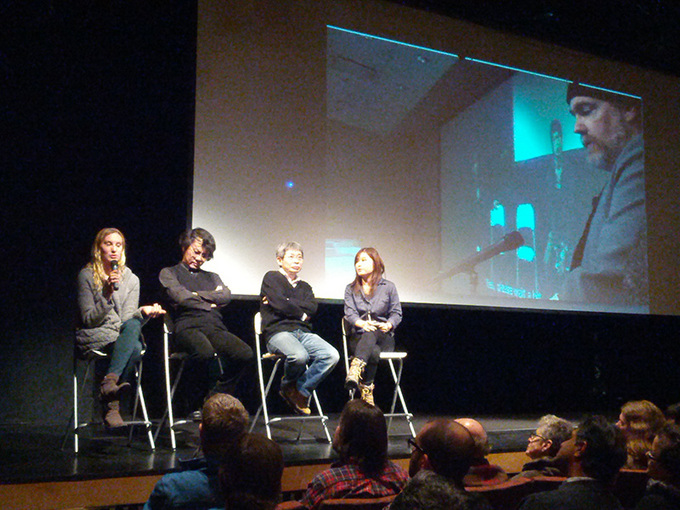North American Audiences' Reaction to Robotics Theater
Futoshi Miyai
Deputy Director of Performing Arts, Japan Society
From January to March, 2013, the Japan Foundation and Japan Society, New York co-produced the North American tour of the android-human theater Sayonara and the robot-human theater I, Worker. The two plays were presented by playwright and stage director Oriza Hirata's Seinendan Theater Company.
Futoshi Miyai, Japan Society's Deputy Director of Performing Arts, reports on the reaction of American and Canadian audiences to these robot-human productions.
Highly acclaimed North American tour
If one of the important tasks of an artist is to present images or ideas that no one has ever seen or imagined, it can be said that Oriza Hirata's recent North American tour more-than-admirably fulfilled that role. In an enterprise never attempted before, two robots plays Sayonara and I, Worker, written and directed by Mr. Hirata, enthralled and empathized the audiences and theatrical people in the United States and Canada.
Audience statistics amply support this: attendances throughout the tour averaged 96%, and advanced bookings at the Flynn Center in Burlington, Vermont, and the Canadian Stage Company in Toronto, Ontario, were so promising that the additional performances were decided a few months ahead of the tour. Expectations were already running high, even before the plays arrived.
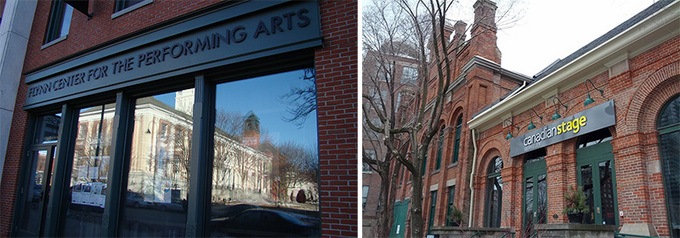
(Left) Flynn Center for the Performing Arts, Burlington, Vermont
(Right) Canadian Stage Company, Toronto, Ontario
A total of 2,833 people (out of 2,942 seats available overall) attended the 18 performances given at six towns and cities in Canada and the United States. The results of the survey distributed at the performances showed that 90% of those who attended answered either "highly satisfied" or "satisfied". Regarding the question of whether the plays were helpful in understanding Japanese culture and technological efforts, 83% agreed that they were "very helpful" or "helpful", attesting to a very warm reception.
Japan Society, a non-profit American organization based in New York, and the Japan Foundation joined hands to make possible this North American tour of the collaboration between the Seinendan Theater Company and the Osaka University Robot Theater Project, with the opening performance taking place at the Wexner Center for the Arts in Columbus, Ohio. Over the next 42 days, the plays toured six venues in six towns and cities across Canada and the United States.
In this report, I would like to talk about the reactions of North American audiences, theatrical people and the media, and my observations of the production processes at the various venues.
 The android play Sayonara, performed by human and android actors, emerged as a result of long years of collaboration between Oriza Hirata and Dr. Hiroshi Ishiguro, creator of robots and androids (Osaka University and ATR IRC Laboratories). Set in the near future where humans and androids co-exist, a young girl dealing with a fatal illness shares her thoughts with an android; the play focuses on human nature, the meaning of human life and death.
The android play Sayonara, performed by human and android actors, emerged as a result of long years of collaboration between Oriza Hirata and Dr. Hiroshi Ishiguro, creator of robots and androids (Osaka University and ATR IRC Laboratories). Set in the near future where humans and androids co-exist, a young girl dealing with a fatal illness shares her thoughts with an android; the play focuses on human nature, the meaning of human life and death.
Photos: Julie Lemberger
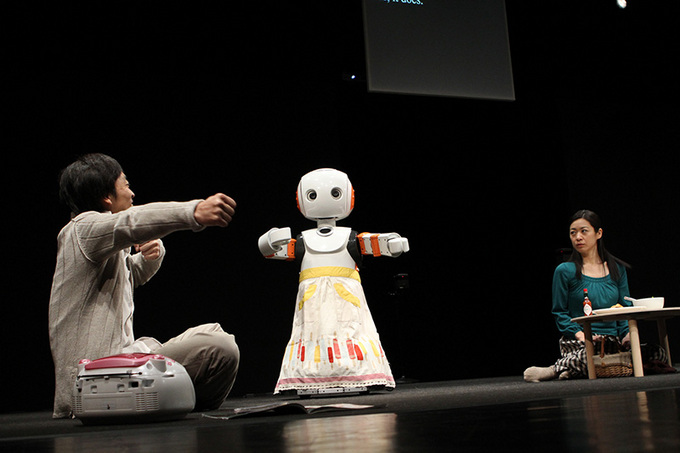
A heart-warming comedy performed by human actors and robots, I, Worker is a story set in the near future about a couple and their two maid robots. Although created to do household chores, the "maids" lose interest in their work for some reason and the play centers around the meaning of work itself.
Photos: Julie Lemberger
Surprise and empathy
"The Japanese have always been very sophisticated about how they develop robotics and artificial intelligence. But they really view ... them with kind of human characteristics," "The audience's empathy for the robots and the androids and what they go through is actually sort of the surprise element of this show," said Chuck Helm, director of performing arts at the Wexner Center for the Arts. (The Lantern, January 30, 2013)
Elsewhere, danceviewtimes, in its February 9, 2013 edition, commented "Ever since the fictional Doctor Frankenstein created his monster, human beings have been worrying about what may happen to them at the hands of their own human-like creations. Usually those worries have been about robots seizing power with their superior strength and intelligence. But now, in the work of Japanese playwright and director Oriza Hirata, we see humans' simply ceding power to artificial beings that are not just stronger and more intelligent, but more emotionally sensitive and stable than their human masters. That's the theme of these unsettling short plays, in which human performers interact with 'live' robots and androids."
Audiences were astonished to see that the robots and androids were more sensitive than human beings, full of affection and at times capable of actions that were more thoughtful than their human counterparts. Rather than identifying with the actors, the spectators were moved by the "human" qualities of the robots and androids and found themselves empathizing with them. This is illustrated by the following two comments.
"There is real tenderness in the scenes when Inue [Ikue] tries to convince Takeo to at least take a walk, while Mimoko [Momoko] tries to lift Yuuji's funk by asking him to teach her to cook his favorite curry." (The Village Voice, February 6, 2013)
"So when the android is sent off to work amongst nuclear ruins after her client's death, she is 'happy' to be of use, and the audience is sad to see her go." (Show Business Weekly, February 15, 2013)
These reactions are probably not that different from what Japanese audiences have. Although the idea of an inanimate object possessing a soul may not be widespread, and robots and androids would not be regarded as near kin--the Japanese think of Astro Boy as one of their kind--the depictions in Sayonara and I, Worker must have come as a pleasant surprise to North American audiences.
"Human-like" robots' acting ability
To be honest, robots and androids are no more than material objects and, at this stage, they are not capable of displaying human attributes. The robots and androids do not understand the feelings of the characters they are playing or the meanings of the words: they have simply been pre-programmed to move in certain ways. An operator stands in the wings and handles the control keys that make the robot reproduce the desired action. Audiences, however, are taken by surprise when they find themselves being moved by the "humanness" of the robots.
Of course this is the ingenuity of the play itself, but it is also the culmination of endless efforts being made to overcome technical glitches and to make minute adjustments. In an interview given to The Columbus Dispatch (January 31, 2013) American actress Bryerly Long talks about her role in Sayonara. "'The timing of the dialogue and movements are always the same, rather than varying slightly in each performance, as tends to happen with live actors.' The biggest challenge, she said, is the rhythm of the interactions. 'I have to be very careful to time what I say so that it will fit with the robot's replies. If I am too early, then there will be an awkward pause before the robot speaks; and if I am too late, then the robot will interrupt me."' Mr. Hirata's directions to the actors are also very precise, such as "one-half of a second later" or "one-third of a second shorter," so understanding his requirements is only possible with actors who have worked with him for many years.
Directions for the robots are also meticulous. He might ask the programmer to "let the neck tilt another 5 degrees" and the programmer will input the new data into the computer. When they come to check the adjustments and let the robot go through the movements again, they see that it "looks as though it's thinking deeply" and "definitely in a dilemma," a marked improvement on its previous attempt. The interesting thing is Hirata's instructions for the robot are almost the same as those for the actors. It may be an eye-opener for American actors and theatrical people who are devoted to realism and method acting.
New values created by artists
"What would life be like with robots or androids as servants? The Japanese might have an answer. Just as Japan has been on the cutting edge of integrating robots into daily life, Seinendan Theater Company of Tokyo and the Osaka University Robot Theater Project have been integrating robots into live theater pieces about the effect of technology on people." (The Columbus Dispatch, January 31, 2013)
An important task of an artist is to show audiences events or situations that they cannot experience, bestowing on them the power to imagine and supplying the basic foundations. Robots have not yet reached the point where they are an integral part of people's daily lives, living side by side with humans. But they are close to reaching that point. When that time comes, how will robots and people actually co-exist? (This is a question that can also be applied to problems of intercultural communications.) In the world of cinema, computer graphics technology has enabled movie makers to present mock-up versions of the life with robots, but the live theater has made the experience even more realistic. Movies maintain the vestiges of fabrication, but in the theater we see real actors and real robots occupying the same air space as the audience. No doubt, people's reactions to this experience will be of great use of the development of robots, and these robot plays have surely provided North American audiences with the opportunity to think about a future where they will be living with cutting edge technology.
On a different aspect, Columbus Alive in its January 31, 2013 edition pointed out, "Despite the android and robot characters' immortality, their presence in a dramatic theater setting helps highlight the humanity -- for better or worse -- of the other, flesh-and-blood characters and, ostensibly, the audience. For example, part of the "Sayonara" plot involves the release of radioactivity at the Fukushima Daiichi nuclear power plant after the 2011 tsunami. While considering the pain technology can bring us, audience members are simultaneously reminded of the groundbreaking things it has done as well... like making an android acting in a play."
After the Fukushima disaster, it was suggested that robots could be sent into the highly contaminated areas and carry out tasks that could not be done by human workers because of the radiation risks. It was the idea of using the latest technology to cope with an unprecedented disaster of the highest order. The United States is already the leader in developing robots that can be sent into extremely dangerous areas, so this scene would not have been difficult to comprehend.
But in Sayonara, a high-tech android interacts with a human being to alleviate a feeling of the pain in her heart. This could be regarded as an evidence of the Japanese mentality in dealing with the latest scientific inventions. (It reminds me of the scene where the worker who has come to pick up the android bows to it as if to say, "Sorry." The fact that humans can convey sentiments like apology or gratitude to a machine must have intrigued the audience.)
Looking back on the tour
The time set aside for preparations for this tour was mostly taken up with fine-tuning the robots. In order to simplify the stage arrangements at each theater, the acting areas at all the venues were planned the same size and program preparations in Japan followed these configurations. Despite these careful arrangements, a robot fell off the stage during the dress rehearsal at the first venue, the Wexner Center for the Arts. The damage, however, was kept to a minimum, with spare parts quickly sent from Japan and other parts procured locally.
In addition to the performances, Japan Society in New York offered a lecture by Dr. Hiroshi Ishiguro and a workshop by the director Oriza Hirata. There were also special lectures at The City University of New York, and the actors joined the audience in post-performance chats. At the Wexner Center for the Arts, technology students and theater-studies students from The Ohio State University discussed the plays from their various viewpoints, and at the Canadian Stage Company, Oriza Hirata gave a reading of another of his works and students held an exhibition of their own robots, all testifying to the great interest generated by the tour. At times, these efforts at educational outreach can be a burden for the artists, but they are an important element of overseas tours like this one which receive government subsidies and which serve the purpose of introducing these new endeavors to other countries. Audiences and theater-related people overseas are eager to listen to what the artists really think, even if they don't feel at home speaking English. The audiences found Mr. Hirata very approachable and were fascinated by his workshops and readings, and were able to get to know Japanese culture from many new angles.
As well as North America, audiences and theatrical people overseas are showing an interest in getting to see plays that offer a slice of present-day Japanese culture, that present new sense of values, and that have never been seen before. The question asked here is "why do we need to show these particular plays to overseas audiences?" The tour of robot plays was able to respond beyond measure to this concern, as was amply demonstrated by the reactions of the audiences, theater people and media.

In New York, Oriza Hirata and Dr. Hiroshi Ishiguro talked with the audience after the performances on February 8 and 9, 2013. The performance on the second day was relayed over the Internet to a theater at the University of Illinois and members of that audience also took part in the discussions. The top photo shows an audience member in Illinois asking a question.
Photo: Japan Society
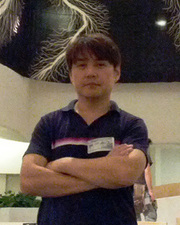 Futoshi Miyai
Futoshi Miyai
Futoshi Miyai was born in 1967 in Wakayama Prefecture. In 1996, he moved to New York as a Saison Foundation Fellow and received a Master of Arts degree in Arts Administration Program in Columbia University in 1999. In July of the same year, he joined Japan Society in New York as a staff. He has worked with the Society's Performing Arts Program as a production coordinator and has been Deputy Director since 2004.
Oriza Hirata's Seinendan Theater Company to Tour North America to Perform a Double-Bill of one-act plays: Android-Human Theater Sayonara and Robot-Human Theater I, Worker:
Performance Schedule
Columbus, Ohio, USA
Dates: Thursday, January 31 - Saturday, February 2, 2013
Venue: Wexner Center for the Arts
New York, New York, USA
Dates: Thursday, February 7- Saturday, February 9, 2013
Venue: Japan Society
Philadelphia, Pennsylvania, USA
Dates: Friday, February 15 - Saturday, February 16, 2013
Venue: Philadelphia Live Arts
Burlington, Vermont, USA
Dates: Thursday, February 21 - Friday, February 22, 2013
Venue: Flynn Center for the Performing Arts
Toronto, Ontario, Canada
Dates: Tuesday, February 26 - Saturday, March 2, 2013
Venue: Canadian Stage Company
Pittsburg, Pennsylvania, USA
Dates: Friday, March 8 and Saturday, March 9, 2013
Venue: The Andy Warhol Museum
Keywords
- Film
- Theater
- Science Technology
- Japan
- Canada
- United States
- Japan Society New York
- Oriza Hirata
- Android
- Robot
- New York
- Flynn Center
- Canadian Stage Company
- Wexner Center for the Arts
- Artificial intelligence
- Bryerly Long
- The Village Voice
- Show Business Weekly
- The Columbus Dispatch
- Columbus Alive
- Great East Japan Earthquake
- Nuclear accident
- Hiroshi Ishiguro
- The City University of New York
- The Ohio State University
Back Issues
- 2025.5. 1 Ukrainian-Japanese I…
- 2024.11. 1 Placed together, we …
- 2024.5.24 The 50th Japan Found…
- 2024.5.24 The 50th Japan Found…
- 2024.5. 2 People-to-People Exc…
- 2024.2.19 Movie Theaters aroun…
- 2024.2.19 Movie Theaters aroun…
- 2023.4.24 The 49th Japan Found…
- 2022.10.24 Inner Diversity <2> …
- 2022.10. 5 Living Together with…


